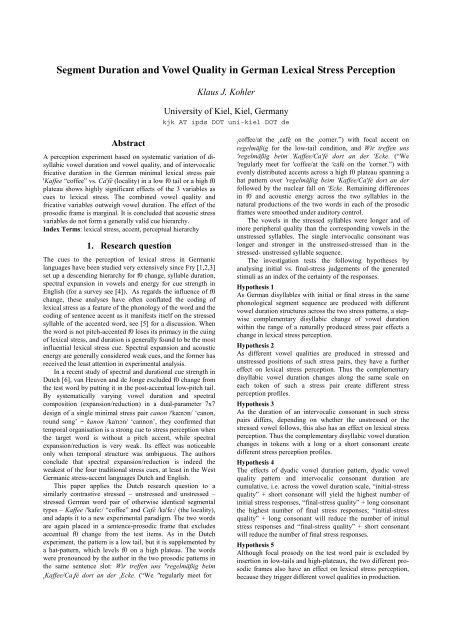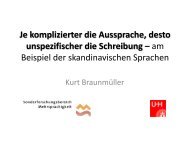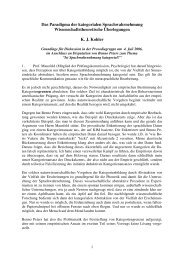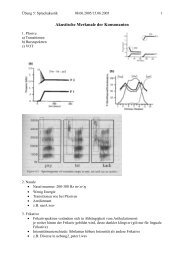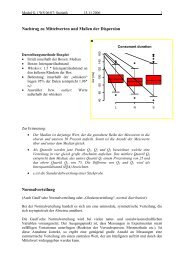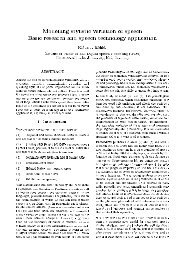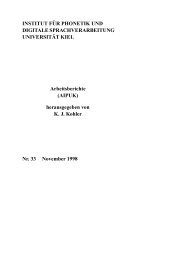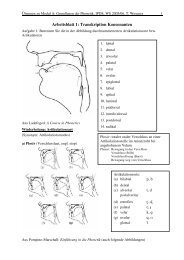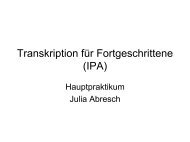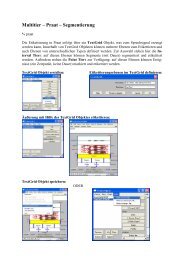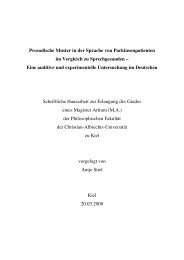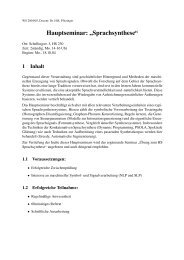Segment Duration and Vowel Quality in German Lexical Stress ...
Segment Duration and Vowel Quality in German Lexical Stress ...
Segment Duration and Vowel Quality in German Lexical Stress ...
You also want an ePaper? Increase the reach of your titles
YUMPU automatically turns print PDFs into web optimized ePapers that Google loves.
<strong>Segment</strong> <strong>Duration</strong> <strong>and</strong> <strong>Vowel</strong> <strong>Quality</strong> <strong>in</strong> <strong>German</strong> <strong>Lexical</strong> <strong>Stress</strong> Perception<br />
Klaus J. Kohler<br />
University of Kiel, Kiel, <strong>German</strong>y<br />
kjk AT ipds DOT uni-kiel DOT de<br />
Abstract<br />
A perception experiment based on systematic variation of disyllabic<br />
vowel duration <strong>and</strong> vowel quality, <strong>and</strong> of <strong>in</strong>tervocalic<br />
fricative duration <strong>in</strong> the <strong>German</strong> m<strong>in</strong>imal lexical stress pair<br />
'Kaffee “coffee” vs. Ca'fé (locality) <strong>in</strong> a low f0 tail or a high f0<br />
plateau shows highly significant effects of the 3 variables as<br />
cues to lexical stress. The comb<strong>in</strong>ed vowel quality <strong>and</strong><br />
fricative variables outweigh vowel duration. The effect of the<br />
prosodic frame is marg<strong>in</strong>al. It is concluded that acoustic stress<br />
variables do not form a generally valid cue hierarchy.<br />
Index Terms: lexical stress, accent, perceptual hierarchy<br />
1. Research question<br />
The cues to the perception of lexical stress <strong>in</strong> <strong>German</strong>ic<br />
languages have been studied very extensively s<strong>in</strong>ce Fry [1,2,3]<br />
set up a descend<strong>in</strong>g hierarchy for f0 change, syllable duration,<br />
spectral expansion <strong>in</strong> vowels <strong>and</strong> energy for cue strength <strong>in</strong><br />
English (for a survey see [4]). As regards the <strong>in</strong>fluence of f0<br />
change, these analyses have often conflated the cod<strong>in</strong>g of<br />
lexical stress as a feature of the phonology of the word <strong>and</strong> the<br />
cod<strong>in</strong>g of sentence accent as it manifests itself on the stressed<br />
syllable of the accented word, see [5] for a discussion. When<br />
the word is not pitch-accented f0 loses its primacy <strong>in</strong> the cu<strong>in</strong>g<br />
of lexical stress, <strong>and</strong> duration is generally found to be the most<br />
<strong>in</strong>fluential lexical stress cue. Spectral expansion <strong>and</strong> acoustic<br />
energy are generally considered weak cues, <strong>and</strong> the former has<br />
received the least attention <strong>in</strong> experimental analysis.<br />
In a recent study of spectral <strong>and</strong> durational cue strength <strong>in</strong><br />
Dutch [6], van Heuven <strong>and</strong> de Jonge excluded f0 change from<br />
the test word by putt<strong>in</strong>g it <strong>in</strong> the post-accentual low-pitch tail.<br />
By systematically vary<strong>in</strong>g vowel duration <strong>and</strong> spectral<br />
composition (expansion/reduction) <strong>in</strong> a dual-parameter 7x7<br />
design of a s<strong>in</strong>gle m<strong>in</strong>imal stress pair canon / ‘canon,<br />
round song’ ~ kanon // ‘cannon’, they confirmed that<br />
temporal organisation is a strong cue to stress perception when<br />
the target word is without a pitch accent, while spectral<br />
expansion/reduction is very weak. Its effect was noticeable<br />
only when temporal structure was ambiguous. The authors<br />
conclude that spectral expansion/reduction is <strong>in</strong>deed the<br />
weakest of the four traditional stress cues, at least <strong>in</strong> the West<br />
<strong>German</strong>ic stress-accent languages Dutch <strong>and</strong> English.<br />
This paper applies the Dutch research question to a<br />
similarly contrastive stressed – unstressed <strong>and</strong> unstressed –<br />
stressed <strong>German</strong> word pair of otherwise identical segmental<br />
types – Kaffee /'kafe:/ “coffee” <strong>and</strong> Café /ka'fe:/ (the locality),<br />
<strong>and</strong> adapts it to a new experimental paradigm. The two words<br />
are aga<strong>in</strong> placed <strong>in</strong> a sentence-prosodic frame that excludes<br />
accentual f0 change from the test items. As <strong>in</strong> the Dutch<br />
experiment, the pattern is a low tail, but it is supplemented by<br />
a hat-pattern, which levels f0 on a high plateau. The words<br />
were pronounced by the author <strong>in</strong> the two prosodic patterns <strong>in</strong><br />
the same sentence slot: Wir treffen uns "regelmäßig beim<br />
Kaffee/Café dort an der Ecke. (“We "regularly meet for<br />
coffee/at the café on the corner.”) with focal accent on<br />
regelmäßig for the low-tail condition, <strong>and</strong> Wir treffen uns<br />
'regelmäßig beim 'Kaffee/Ca'fé dort an der 'Ecke. (“We<br />
'regularly meet for 'coffee/at the 'café on the 'corner.”) with<br />
evenly distributed accents across a high f0 plateau spann<strong>in</strong>g a<br />
hat pattern over 'regelmäßig beim 'Kaffee/Ca'fé dort an der<br />
followed by the nuclear fall on 'Ecke. Rema<strong>in</strong><strong>in</strong>g differences<br />
<strong>in</strong> f0 <strong>and</strong> acoustic energy across the two syllables <strong>in</strong> the<br />
natural productions of the two words <strong>in</strong> each of the prosodic<br />
frames were smoothed under auditory control.<br />
The vowels <strong>in</strong> the stressed syllables were longer <strong>and</strong> of<br />
more peripheral quality than the correspond<strong>in</strong>g vowels <strong>in</strong> the<br />
unstressed syllables. The s<strong>in</strong>gle <strong>in</strong>tervocalic consonant was<br />
longer <strong>and</strong> stronger <strong>in</strong> the unstressed-stressed than <strong>in</strong> the<br />
stressed- unstressed syllable sequence.<br />
The <strong>in</strong>vestigation tests the follow<strong>in</strong>g hypotheses by<br />
analys<strong>in</strong>g <strong>in</strong>itial vs. f<strong>in</strong>al-stress judgements of the generated<br />
stimuli as an <strong>in</strong>dex of the certa<strong>in</strong>ty of the responses.<br />
Hypothesis 1<br />
As <strong>German</strong> disyllables with <strong>in</strong>itial or f<strong>in</strong>al stress <strong>in</strong> the same<br />
phonological segment sequence are produced with different<br />
vowel duration structures across the two stress patterns, a stepwise<br />
complementary disyllabic change of vowel duration<br />
with<strong>in</strong> the range of a naturally produced stress pair effects a<br />
change <strong>in</strong> lexical stress perception.<br />
Hypothesis 2<br />
As different vowel qualities are produced <strong>in</strong> stressed <strong>and</strong><br />
unstressed positions of such stress pairs, they have a further<br />
effect on lexical stress perception. Thus the complementary<br />
disyllabic vowel duration changes along the same scale on<br />
each token of such a stress pair create different stress<br />
perception profiles.<br />
Hypothesis 3<br />
As the duration of an <strong>in</strong>tervocalic consonant <strong>in</strong> such stress<br />
pairs differs, depend<strong>in</strong>g on whether the unstressed or the<br />
stressed vowel follows, this also has an effect on lexical stress<br />
perception. Thus the complementary disyllabic vowel duration<br />
changes <strong>in</strong> tokens with a long or a short consonant create<br />
different stress perception profiles.<br />
Hypothesis 4<br />
The effects of dyadic vowel duration pattern, dyadic vowel<br />
quality pattern <strong>and</strong> <strong>in</strong>tervocalic consonant duration are<br />
cumulative, i.e. across the vowel duration scale, “<strong>in</strong>itial-stress<br />
quality” + short consonant will yield the highest number of<br />
<strong>in</strong>itial stress responses, “f<strong>in</strong>al-stress quality” + long consonant<br />
the highest number of f<strong>in</strong>al stress responses; “<strong>in</strong>itial-stress<br />
quality” + long consonant will reduce the number of <strong>in</strong>itial<br />
stress responses <strong>and</strong> “f<strong>in</strong>al-stress quality” + short consonant<br />
will reduce the number of f<strong>in</strong>al stress responses.<br />
Hypothesis 5<br />
Although focal prosody on the test word pair is excluded by<br />
<strong>in</strong>sertion <strong>in</strong> low-tails <strong>and</strong> high-plateaux, the two different prosodic<br />
frames also have an effect on lexical stress perception,<br />
because they trigger different vowel qualities <strong>in</strong> production.
2.1. Stimulus generation<br />
2. Method<br />
Table 1 lists the durations <strong>and</strong> mid-vowel formant frequencies<br />
F1, F2, F3 of the first-syllable /a/ <strong>and</strong> the second-syllable /e:/,<br />
as well as the duration of the <strong>in</strong>tervocalic fricative /f/ of<br />
Kaffee/Café <strong>in</strong> both prosodic frames.<br />
Table 1. <strong>Duration</strong>s (<strong>in</strong> ms) <strong>and</strong> formant frequencies<br />
F1, F2, F3 (<strong>in</strong> Hz, mid-vowel position) of the vowels<br />
/a/, /e:/, <strong>and</strong> durations of the fricative /f/ <strong>in</strong> “Kaffee”<br />
<strong>and</strong> “Café” of the low-tail <strong>and</strong> high-plateau frames.<br />
low<br />
high<br />
Kaffee Café Kaffee Café<br />
ms<br />
Hz<br />
ms<br />
Hz<br />
ms<br />
Hz<br />
ms<br />
Hz<br />
/a/ dur 110 88 124 96<br />
F1 545 482 510 495<br />
F2 1504 1682 1427 1528<br />
F3 3121 3316 2974 3110<br />
/e:/ dur 98 112 126 135<br />
F1 383 352 409 357<br />
F2 1795 1920 1955 1941<br />
F3 3251 3336 3270 3335<br />
/f/ dur 76 104 72 100<br />
The /k/ release + aspiration has very similar durations <strong>in</strong><br />
all 4 words (Kaffee low 53 ms, Café low 54 ms, Kaffee high<br />
62 ms, Café high 65 ms), but their spectra are different, so it is<br />
the whole syllable /ka/ that differs across both words <strong>and</strong> both<br />
sentence frames.<br />
The words Kaffee <strong>and</strong> Café were excerpted from the<br />
frames <strong>and</strong> 100 ms of silence added at the right end to guarantee<br />
proper f0 <strong>and</strong> energy analysis <strong>in</strong> praat. As the vowels <strong>in</strong><br />
Café had equal energy maxima <strong>in</strong> both vowels, the lower<br />
energy <strong>in</strong> the second vowel of Kaffee was raised by 4 dB <strong>in</strong><br />
the tail <strong>and</strong> by 2 dB <strong>in</strong> the high plateau frame <strong>in</strong> CoolEdit to<br />
equalize. The f0 courses were levelled to auditory pitch equality<br />
<strong>in</strong> the two syllables by us<strong>in</strong>g Manipulation <strong>in</strong> praat, leav<strong>in</strong>g<br />
microprosodic fluctuations to guarantee natural sound quality.<br />
Disyllabic vowel duration was then varied <strong>in</strong> a complementary<br />
fashion <strong>in</strong> praat to create 5 steps from equal to long1-<br />
short1, long2-short2 <strong>and</strong> short1-long1, short2-long2 for the<br />
word pair <strong>in</strong> both prosodic patterns, creat<strong>in</strong>g 4 duration series,<br />
one from orig<strong>in</strong>al Kaffee <strong>and</strong> one from orig<strong>in</strong>al Café <strong>in</strong> each of<br />
the two prosodic frames. Table 2 gives the result<strong>in</strong>g vowel<br />
duration scales for the word pair <strong>in</strong> either prosodic frame. The<br />
5 * 4 f0 <strong>and</strong> duration manipulations of the word excerpts from<br />
the orig<strong>in</strong>al utterances were then psola resynthesized <strong>in</strong> praat.<br />
Table 2. The complementary first-second vowel durations<br />
(equal, long1-short1, long2-short2 <strong>and</strong> short1-<br />
long1, short2-long2 for both “Kaffee” <strong>and</strong> “Café” <strong>in</strong><br />
either the low-tail or the high-plateau frame.<br />
EQU L1S L2S S1L S2L<br />
l-tail 100-100 110-90 120-80 90-110 80-120<br />
h-plat 115-115 125-105 135-95 105-125 95-135<br />
In each of the 20 resynthesized wav files, the /f/ section<br />
was removed <strong>and</strong> replaced by the /f/ section from both the<br />
orig<strong>in</strong>al Kaffee <strong>and</strong> the orig<strong>in</strong>al Café, <strong>in</strong> the low <strong>and</strong> the high<br />
frame, respectively, thus generat<strong>in</strong>g 2 x 5 x 4 = 40 wav files.<br />
The 20 low-pitched <strong>and</strong> the 20 high-pitched word files were<br />
then spliced <strong>in</strong>to the low-tail <strong>and</strong> high-plateau, respectively.<br />
The sentence frame was <strong>in</strong> either case taken from the orig<strong>in</strong>al<br />
utterance conta<strong>in</strong><strong>in</strong>g Kaffee. The result<strong>in</strong>g stimuli sounded<br />
fluent <strong>and</strong> completely natural without any technical artefact.<br />
This experimental design can test whether there are<br />
different profiles of <strong>in</strong>itial <strong>and</strong> f<strong>in</strong>al stress perception for the<br />
vowel duration series imposed on the two disyllables, which,<br />
due to their dist<strong>in</strong>ct orig<strong>in</strong>al dynamic patterns, differ <strong>in</strong> their<br />
vocalic qualities <strong>and</strong> <strong>in</strong> the duration <strong>and</strong> <strong>in</strong>tensity of the<br />
<strong>in</strong>tervocalic fricative. Thus the aim of the paper is to quantify<br />
this <strong>in</strong>terdependence between segmental duration <strong>and</strong> vowel<br />
quality, <strong>and</strong> to assess its adjustment to two different prosodic<br />
patterns, which both elim<strong>in</strong>ate macroprosodic f0 movements<br />
across the disyllables, but leave microprosodic ones <strong>in</strong> to<br />
guarantee a natural sound quality.<br />
2.2. Test files<br />
The stimuli were <strong>in</strong>dexed accord<strong>in</strong>g to 4 parameters:<br />
• F0 Frame high, low – Fh, Fl.<br />
• <strong>Vowel</strong> quality dyad Word Kaffee, Café – Wk, Wc.<br />
• <strong>Vowel</strong> duration dyad equal, long1-short1, long2-<br />
short2, short1-long1, short2-long2 – EQU, L1S, L2S,<br />
S1L, S2L.<br />
• Fricative Consonant long, short – Cl, Cs.<br />
In the stimulus name, the parameter labels are given <strong>in</strong> the<br />
above order, separated by _, e.g. Fh_Wc_EQU_Cl. The vowel<br />
duration patterns L2S, L1S, EQU, S1L, S2L form a scale of<br />
descend<strong>in</strong>g first vowel durations, <strong>and</strong> a concomitantly<br />
ascend<strong>in</strong>g scale <strong>in</strong> the second vowel, go<strong>in</strong>g through equal.<br />
Two test files were created for two perception tests with<br />
the Kiel reaction measur<strong>in</strong>g <strong>in</strong>strumentation for record<strong>in</strong>g<br />
responses <strong>and</strong> reaction times. All the generated stimuli were<br />
duplicated 5 times. The 5x20 high-plateau stimuli were<br />
r<strong>and</strong>omized <strong>in</strong> test Fh, the 5x20 low-tail stimuli <strong>in</strong> test Fl. The<br />
length of the answer<strong>in</strong>g w<strong>in</strong>dow was 4 sec. The sequence of<br />
test Fh <strong>and</strong> test Fl was changed for different subject groups to<br />
get a balanced test paradigm.<br />
2.3. Subjects <strong>and</strong> tests<br />
16 students of l<strong>in</strong>guistics <strong>and</strong> languages (3 male, 13 female, 1<br />
male 66 yrs, 1 female 33 yrs, the rest 21-26yrs) did the two listen<strong>in</strong>g<br />
tests <strong>in</strong> 4 groups of (a) 5, (b) 4, (c) 5 <strong>and</strong> (d) 2, respectively.<br />
Each group did both tests <strong>in</strong> one session, groups (a) <strong>and</strong><br />
(d) <strong>in</strong> the order Fh – Fl, groups (b) <strong>and</strong> (c) <strong>in</strong> the reverse<br />
order. The subjects were given simultaneous written <strong>and</strong> oral<br />
<strong>in</strong>structions. These <strong>in</strong>structions provided illustrations of word<br />
differentiation by different stress placement. The word pair<br />
Kaffee vs. Café was <strong>in</strong>troduced as a m<strong>in</strong>imal pair with 1stsyllable<br />
<strong>and</strong> 2nd-syllable stress, respectively, to differentiate<br />
the dr<strong>in</strong>k from the locality <strong>in</strong> the northern variety of <strong>German</strong>.<br />
S<strong>in</strong>ce it could not be ruled out altogether that subjects might<br />
also use f<strong>in</strong>al stress for the dr<strong>in</strong>k, subjects were told that they<br />
should decide whether they heard the word <strong>in</strong> the utterance<br />
with stress on the first or the second syllable. They were to<br />
give their answers by press<strong>in</strong>g either button 1 or button 2 of<br />
the response boxes <strong>in</strong> front of them, <strong>and</strong> to react as quickly as<br />
possible follow<strong>in</strong>g perception. They were told that there may<br />
be uncerta<strong>in</strong> cases, but that they should still come to a quick<br />
decision. The <strong>in</strong>structions were followed by a practice run of
espond<strong>in</strong>g to 10 stimuli, 5 from Fl, then 5 from Fh. The test<br />
session took 15 m<strong>in</strong>utes for each test <strong>and</strong> about 10 m<strong>in</strong>utes for<br />
the <strong>in</strong>structions, i.e. a total of approximately 45 m<strong>in</strong>utes.<br />
3. Results<br />
There were 17 responses miss<strong>in</strong>g <strong>in</strong> the high-plateau <strong>and</strong> 6 <strong>in</strong><br />
the low-tail frame, <strong>in</strong> each case out of 16*100, i.e. ≤ 1%,<br />
which means that the data are reliable. S<strong>in</strong>ce the misses are<br />
spread r<strong>and</strong>omly across stimuli <strong>and</strong> subjects, they are treated<br />
as non-1 responses.<br />
Figure 1 breaks the response data down <strong>in</strong>to the two test<br />
frames Fh <strong>and</strong> Fl, <strong>and</strong> the two vowel quality dyads Wc <strong>and</strong><br />
Wk <strong>in</strong> each, along the 5-po<strong>in</strong>t vowel duration scale, separat<strong>in</strong>g<br />
the fricative durations Cl <strong>and</strong> Cs at each po<strong>in</strong>t. The graph<br />
shows that the two vowel quality dyads form dist<strong>in</strong>ct sets <strong>in</strong><br />
both frames, po<strong>in</strong>t by po<strong>in</strong>t along the scale for correspond<strong>in</strong>g<br />
fricative durations.<br />
Figure 1: Relative frequencies of “1st syllable stressed”<br />
responses to each of the 20 test stimuli <strong>in</strong> the highplateau<br />
(Fh, left). <strong>and</strong> the low-tail (Fl, right).<br />
Pla<strong>in</strong>/dotted l<strong>in</strong>es connect responses to Wk/Wc for Cl<br />
<strong>and</strong> Cs along the 5-po<strong>in</strong>t duration scale L2S to S2L.<br />
Proportions out of 80 responses <strong>in</strong> each case.<br />
Figure 2 breaks the data down further <strong>in</strong>to the 4<br />
comb<strong>in</strong>ations of vowel quality <strong>and</strong> fricative duration Wk_Cs,<br />
Wk_Cl, Wc_Cs, Wc_Cl. From this graph we can deduce:<br />
(1.1) In both frames, the stimuli Wk_Cs (orig<strong>in</strong>al Kaffee<br />
with short /f/) show decreas<strong>in</strong>g <strong>in</strong>itial-stress responses along<br />
the duration scale from L2S to S2L, but the relative frequency<br />
for S2L stays around 50%, i.e. there is no change of lexical<br />
stress category from L2S to S2L.<br />
(1.2) For all the correspond<strong>in</strong>g stimuli with the other<br />
vowel dyad quality (orig<strong>in</strong>al Café with short /f/: Wc_Cs),<br />
there are fewer <strong>in</strong>itial-stress judgements <strong>in</strong> both frames, now<br />
result<strong>in</strong>g <strong>in</strong> a lexical stress category change from L2S to S2L.<br />
(1.3) A similar response profile across the duration scale<br />
occurs when short /f/ of Wk_Cs is replaced by long /f / Cl.<br />
(2.1) In both frames, the responses to stimuli Wc_Cl<br />
(orig<strong>in</strong>al Café with long /f/) along the duration scale stay<br />
below or around 50% ‘<strong>in</strong>itial stress’, i.e. there is no category<br />
change <strong>in</strong> the opposite direction from S2L to L2S.<br />
(2.2) For all the correspond<strong>in</strong>g stimuli with the other<br />
vowel dyad quality (orig<strong>in</strong>al Kaffee with long /f/: Wk_Cl),<br />
there are more <strong>in</strong>itial-stress judgements <strong>in</strong> both frames, now<br />
result<strong>in</strong>g <strong>in</strong> a lexical stress category change from S2L to L2S.<br />
(2.3) A similar response profile across the duration scale<br />
occurs when long /f/ of Wc_Cl is replaced by short /f / Cs.<br />
Figure 2: Relative frequencies of “1st syllable stressed”<br />
responses to each of the 20 test stimuli <strong>in</strong> the highplateau<br />
(Fh, left). <strong>and</strong> the low-tail (Fl, right), along the<br />
5-po<strong>in</strong>t duration scale L2S to S2L <strong>in</strong> the 4 sets Wk_Cs,<br />
Wk_Cl, Wc_Cs, Wc_Cl. Proportions out of 80 responses<br />
<strong>in</strong> each case.<br />
These data make it very clear that complementary vowel<br />
duration patterns are not sufficient to differentiate the <strong>German</strong><br />
m<strong>in</strong>imal stress pair 'Kaffee/Ca'fé <strong>in</strong> levelled f0. <strong>Vowel</strong> quality<br />
<strong>in</strong> the two syllables <strong>and</strong> the <strong>in</strong>tervocalic fricative do not just<br />
determ<strong>in</strong>e judgement at vowel durations that are <strong>in</strong>decisive as<br />
to one or the other category, but even at the polar ends of the<br />
duration scale. Their cue value is thus on a par with duration.<br />
The frame has a m<strong>in</strong>or effect on stress perception. The<br />
greatest differences between the two sets relate to the entire<br />
response profiles for Wc_Cs <strong>and</strong> Wc_Cl, <strong>and</strong> to an <strong>in</strong>crease <strong>in</strong><br />
<strong>in</strong>itial-stress responses for the two durations at the left end of<br />
the scale <strong>in</strong> all 4 vowel-quality – fricative pairs of the low-tail.<br />
To test the significance of these observations, a Repeated<br />
Measures ANOVA was applied to the response data with the 4<br />
factors Frame (2 levels high/low, Fh/Fl), Word (2 levels<br />
(orig<strong>in</strong>al) Café/Kaffee, Wc/Wk), <strong>Vowel</strong> <strong>Duration</strong> (5 levels,<br />
L2S – S2L), <strong>and</strong> Fricative (2 levels long/schort, Cl/Cs). The<br />
with<strong>in</strong>-subject factors Word, <strong>Vowel</strong> <strong>Duration</strong> <strong>and</strong> Fricative<br />
yield highly significant ma<strong>in</strong> effects: Word F(1,15)=36.290,<br />
p
4. Discussion<br />
This paper has <strong>in</strong>vestigated the contribution to stress<br />
perception of vowel quality <strong>and</strong> <strong>in</strong>tervocalic fricative duration<br />
besides complementary vowel duration changes <strong>in</strong> the <strong>German</strong><br />
disyllables Kaffee <strong>and</strong> Café, exclud<strong>in</strong>g critical f0 changes on<br />
the test words by plac<strong>in</strong>g them either <strong>in</strong> a low tail or a <strong>in</strong> highplateau<br />
hat pattern of a sentence frame. The analysis of the<br />
response data has confirmed Hypotheses 1-3 as vowel duration,<br />
vowel quality <strong>and</strong> fricative duration have proved to be<br />
strong significant ma<strong>in</strong> effects <strong>in</strong> shap<strong>in</strong>g the stress response<br />
profiles <strong>in</strong> <strong>German</strong> Kaffee vs. Café along the duration scale.<br />
All 4 comb<strong>in</strong>ations of vowel quality <strong>and</strong> fricative duration<br />
create different profiles, but there is no category change <strong>in</strong> the<br />
vowel quality <strong>and</strong> fricative comb<strong>in</strong>ation Wc_Cl, which has the<br />
strongest cue for f<strong>in</strong>al stress <strong>and</strong> does not change to <strong>in</strong>itial<br />
stress even at the appropriate vowel durations, nor <strong>in</strong> Wk_Cs,<br />
which has the strongest cue for <strong>in</strong>itial stress <strong>and</strong> does not<br />
change to f<strong>in</strong>al stress even at the appropriate vowel durations.<br />
In the weaker comb<strong>in</strong>ations Wc_Cs <strong>and</strong> Wk_Cl, where vowel<br />
quality <strong>and</strong> fricative duration provide oppos<strong>in</strong>g cues to <strong>in</strong>itial<br />
or f<strong>in</strong>al stress, the category change occurs. This means that the<br />
vowel quality <strong>and</strong> fricative duration values are cumulative to<br />
create a basic cue power for <strong>in</strong>itial or f<strong>in</strong>al stress, onto which<br />
vowel duration is grafted This applies to both prosodic frames.<br />
Hypothesis 4 has thus also been confirmed.<br />
Hypothesis 5 has not been confirmed, as there are only<br />
marg<strong>in</strong>al effects of such high or low levelled prosodic frames<br />
on stress perception.<br />
5. Conclusions<br />
As f0 on test items is levelled <strong>in</strong> a low tail or a high-plateau<br />
hat pattern vowel quality can become an important cue <strong>in</strong> lexical<br />
stress perception, further enhanced by the strength/<br />
duration of an <strong>in</strong>tervocalic consonant. The comb<strong>in</strong>ed cue force<br />
of these two parameters can outweigh the effect of vowel<br />
duration. van Heuven <strong>and</strong> de Jonge [6] also showed the effect<br />
of vowel quality for the Dutch m<strong>in</strong>imal <strong>in</strong>itial-f<strong>in</strong>al stress pair<br />
canon <strong>and</strong> kanon, but the effect is much smaller.<br />
This is probably due to the different experimental design<br />
<strong>and</strong> to the lack of a proper m<strong>in</strong>imal vowel quantity pair, s<strong>in</strong>ce<br />
canon has a long stressed vowel, kanon a short unstressed one<br />
<strong>in</strong> the first syllable. *// with a short stressed vowel <strong>in</strong> the<br />
first syllable would be a possible phonotactic structure but<br />
does not exist as a word. Therefore, chang<strong>in</strong>g duration along a<br />
7-po<strong>in</strong>t scale that spans the long stressed <strong>and</strong> the short<br />
unstressed vowel <strong>in</strong> the Dutch word pair needs a wider range<br />
than the stressed-unstressed vowels <strong>in</strong> the <strong>German</strong> word pair,<br />
<strong>and</strong> a longer first-syllable vowel for canon identification. The<br />
manipulation of the first-syllable vowel covered a range of<br />
120ms, that of the second syllable 40ms (at a 85/15 ratio for<br />
vowel/f<strong>in</strong>al /n/). This compares with just 40ms <strong>in</strong> the vowels<br />
of both syllables of the <strong>German</strong> pair. Furthermore, the duration<br />
manipulation goes through * which does not have<br />
a straightforward association with canon <strong>in</strong> a word identification<br />
test <strong>and</strong> consequently with <strong>in</strong>itial stress. The most reduced<br />
spectral steps do not go together with the longest duration<br />
steps <strong>in</strong> the production of , <strong>and</strong> listeners may<br />
therefore f<strong>in</strong>d it difficult to allocate them to either "kanon" or<br />
"canon". Similarly, the most exp<strong>and</strong>ed spectral steps do not go<br />
together with the shortest duration steps <strong>in</strong> production, <strong>and</strong><br />
may po<strong>in</strong>t to *, which is not a possible response. Thus<br />
duration is bound to have greater cue strength over vowel<br />
quality. The stimulus synthesis method may also have<br />
<strong>in</strong>terfered with the naturalness of the sound output.<br />
In a similar experiment to the <strong>German</strong> one, [7] manipulated<br />
duration <strong>in</strong> 7 steps across the two syllables of Catalan<br />
mama <strong>and</strong> mamà , rang<strong>in</strong>g from 87-45ms to<br />
45-87ms, i.e. vowel durations are closer to the <strong>German</strong> than to<br />
the Dutch data, <strong>and</strong> range over 40ms as <strong>in</strong> the former. <strong>Vowel</strong><br />
quality has a strong effect: cannot be changed to f<strong>in</strong>al<br />
stress by short-long vowels, <strong>and</strong> vice versa for . The<br />
effect is even stronger than the authors realise because their<br />
<strong>in</strong>struction to listeners to respond only on hear<strong>in</strong>g mamà must<br />
have <strong>in</strong>creased false alarms <strong>and</strong> created a bias towards f<strong>in</strong>al<br />
stress. The results thus parallel the ones for <strong>German</strong>.<br />
This is a field that needs further cross-l<strong>in</strong>guistic <strong>in</strong>vestigation<br />
with more words, <strong>in</strong>clud<strong>in</strong>g different vowel <strong>and</strong> consonant<br />
types. Other test examples for <strong>German</strong> are Das ist<br />
bestimmt für den August nicht typisch. “That is certa<strong>in</strong>ly not<br />
typical for Augustus / the month of August.“ or Bei uns hat<br />
immer die 'Mama/Ma'ma / der 'Papa/Pa'pa das letzte Wort.<br />
“In our house, mum/dad always has the f<strong>in</strong>al word.”, with<br />
different stylistic forms for mum/dad, The same stimulus generation<br />
with the variables <strong>Vowel</strong> <strong>Quality</strong> <strong>and</strong> <strong>Vowel</strong> <strong>Duration</strong><br />
<strong>in</strong> the two syllables, Intervocalic Consonant, Low-tail or Highplateau<br />
frames, <strong>and</strong> the same test design would be applied.<br />
From the limited data we have we can already conclude<br />
that <strong>in</strong>vestigations <strong>in</strong>to the exponents of lexical stress <strong>and</strong> <strong>in</strong>to<br />
their effects on stress perception need to open a broad analysis<br />
w<strong>in</strong>dow that not only spans at least a stressed <strong>and</strong> an unstressed<br />
syllable, but <strong>in</strong>cludes all segmental <strong>and</strong> prosodic<br />
variables <strong>in</strong> it. There is no general hierarchy of the variables<br />
traditionally adduced to signal lexical stress. F0, vowel duration,<br />
vowel quality, consonant duration, acoustic energy operate<br />
together at all times to transmit lexical stress <strong>in</strong>formation.<br />
They do this not just <strong>in</strong> the stressed syllable but across at least<br />
a stressed/unstressed or unstressed/stressed syllable sequence,<br />
<strong>and</strong> the weight of each <strong>in</strong>dividual parameter is adapted to the<br />
contextual <strong>and</strong> situational dem<strong>and</strong>s of speech communication.<br />
Thus, every new prosodic embedd<strong>in</strong>g of syllable sequences<br />
def<strong>in</strong>es the hierarchy afresh, <strong>and</strong> artificial separation of variables<br />
<strong>in</strong> experimental designs should always pay attention to<br />
naturalness <strong>and</strong> communicative appropriateness of the stimuli.<br />
6. References<br />
[1] Fry, D.B., “<strong>Duration</strong> <strong>and</strong> <strong>in</strong>tensity as physical correlates of<br />
l<strong>in</strong>guistic stress”, J. Acoust. Soc. Am. 27, 765-768 , 1955.<br />
[2] Fry, D.B., “Experiments <strong>in</strong> the perception of stress”, Lang.<br />
Speech 1, 126-152, 1958.<br />
[3] Fry, D.B., “The dependence of stress judgments on vowel formant<br />
structure”, <strong>in</strong> Zwirner, Bethge, Proceed<strong>in</strong>gs of the 6th International<br />
Congress of Phonetic Sciences, 306-311, Karger,<br />
Basel, 1965.<br />
[4] Heuven, V.J. van; Sluijter, A.M.C., “Notes on the phonetics of<br />
word prosody”, <strong>in</strong> Goedemans, van der Hulst, Visch, <strong>Stress</strong> patterns<br />
of the world, Part 1: Background, HIL Publications (vol.<br />
2), pp. 233-269, Holl<strong>and</strong> Academic Graphics, The Hague, 1996.<br />
[5] Sluijter, A.M.C.; Heuven, V.J. van, “Effects of focus distribution,<br />
pitch accent <strong>and</strong> lexical stress on the temporal organisation<br />
of syllables <strong>in</strong> Dutch”. Phonetica 52, 71-89,1996.<br />
[6] Heuven, V.J. van, Jonge, M. de, “Spectral <strong>and</strong> temporal<br />
reduction as stress cues <strong>in</strong> Dutch”, Phonetica 68, 1-13, 2011.<br />
[7] Ortega-Llebaria, M., Vanrell, M.M., Prieto, P., “Catalan<br />
speakers’ perception of word stress <strong>in</strong> unaccented contexts”, J.<br />
Acoust. Soc. Am. 127, 462-471, 2011.


